Zhibin Yu
UVEB: A Large-scale Benchmark and Baseline Towards Real-World Underwater Video Enhancement
Apr 27, 2024Abstract:Learning-based underwater image enhancement (UIE) methods have made great progress. However, the lack of large-scale and high-quality paired training samples has become the main bottleneck hindering the development of UIE. The inter-frame information in underwater videos can accelerate or optimize the UIE process. Thus, we constructed the first large-scale high-resolution underwater video enhancement benchmark (UVEB) to promote the development of underwater vision.It contains 1,308 pairs of video sequences and more than 453,000 high-resolution with 38\% Ultra-High-Definition (UHD) 4K frame pairs. UVEB comes from multiple countries, containing various scenes and video degradation types to adapt to diverse and complex underwater environments. We also propose the first supervised underwater video enhancement method, UVE-Net. UVE-Net converts the current frame information into convolutional kernels and passes them to adjacent frames for efficient inter-frame information exchange. By fully utilizing the redundant degraded information of underwater videos, UVE-Net completes video enhancement better. Experiments show the effective network design and good performance of UVE-Net.
Indoor Positioning based on Active Radar Sensing and Passive Reflectors: Concepts & Initial Results
Oct 06, 2023Abstract:To navigate reliably in indoor environments, an industrial autonomous vehicle must know its position. However, current indoor vehicle positioning technologies either lack accuracy, usability or are too expensive. Thus, we propose a novel concept called local reference point assisted active radar positioning, which is able to overcome these drawbacks. It is based on distributing passive retroreflectors in the indoor environment such that each position of the vehicle can be identified by a unique reflection characteristic regarding the reflectors. To observe these characteristics, the autonomous vehicle is equipped with an active radar system. On one hand, this paper presents the basic idea and concept of our new approach towards indoor vehicle positioning and especially focuses on the crucial placement of the reflectors. On the other hand, it also provides a proof of concept by conducting a full system simulation including the placement of the local reference points, the radar-based distance estimation and the comparison of two different positioning methods. It successfully demonstrates the feasibility of our proposed approach.
Channel Pruned YOLOv5-based Deep Learning Approach for Rapid and Accurate Outdoor Obstacles Detection
Apr 27, 2022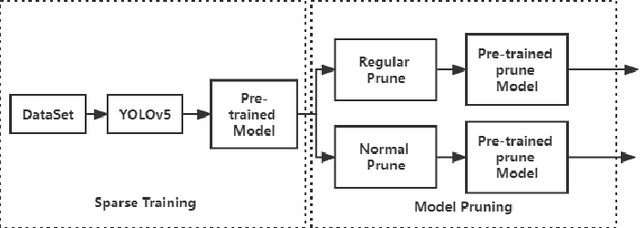


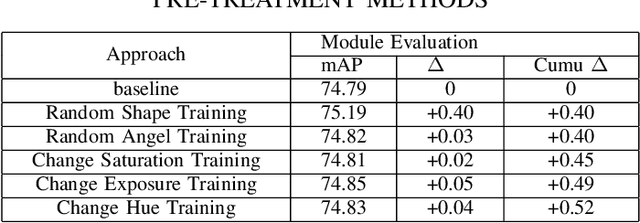
Abstract:One-stage algorithm have been widely used in target detection systems that need to be trained with massive data. Most of them perform well both in real-time and accuracy. However, due to their convolutional structure, they need more computing power and greater memory consumption. Hence, we applied pruning strategy to target detection networks to reduce the number of parameters and the size of model. To demonstrate the practicality of the pruning method, we select the YOLOv5 model for experiments and provide a data set of outdoor obstacles to show the effect of model. In this specific data set, in the best circumstances, the volume of the network model is reduced by 49.7% compared with the original model, and the reasoning time is reduced by 52.5%. Meanwhile, it also uses data processing methods to compensate for the drop in accuracy caused by pruning.
Detecting Mitosis against Domain Shift using a Fused Detector and Deep Ensemble Classification Model for MIDOG Challenge
Aug 31, 2021

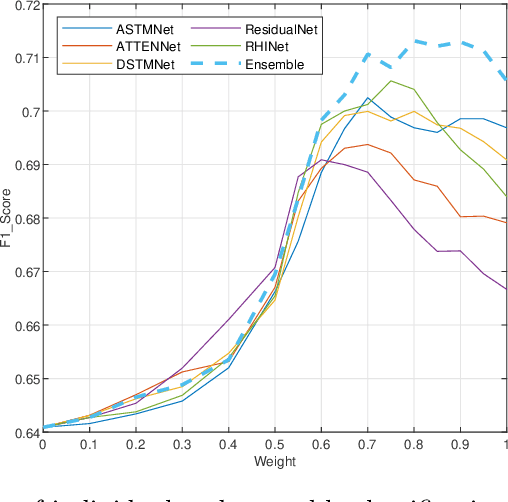
Abstract:Mitotic figure count is an important marker of tumor proliferation and has been shown to be associated with patients' prognosis. Deep learning based mitotic figure detection methods have been utilized to automatically locate the cell in mitosis using hematoxylin \& eosin (H\&E) stained images. However, the model performance deteriorates due to the large variation of color tone and intensity in H\&E images. In this work, we proposed a two stage mitotic figure detection framework by fusing a detector and a deep ensemble classification model. To alleviate the impact of color variation in H\&E images, we utilize both stain normalization and data augmentation, aiding model to learn color irrelevant features. The proposed model obtains an F1 score of 0.7550 on the preliminary testing set released by the MIDOG challenge.
ReshapeGAN: Object Reshaping by Providing A Single Reference Image
May 16, 2019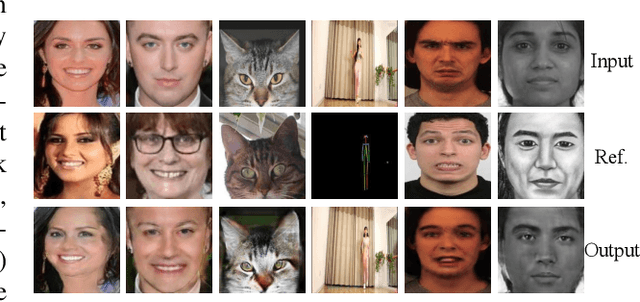
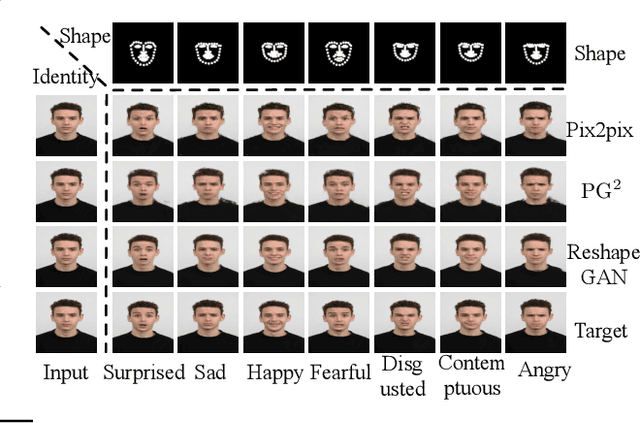
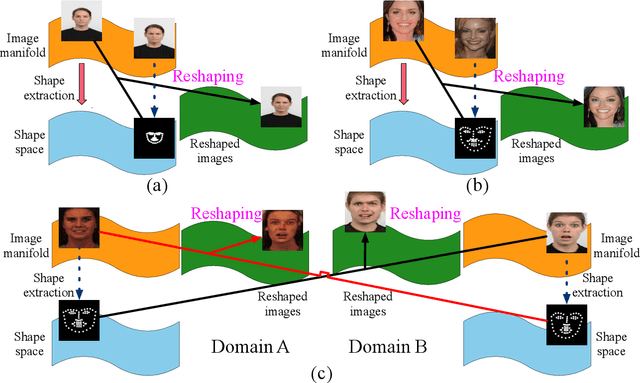
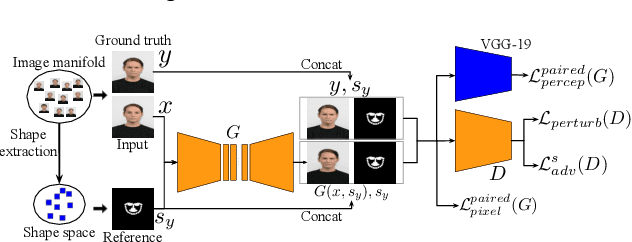
Abstract:The aim of this work is learning to reshape the object in an input image to an arbitrary new shape, by just simply providing a single reference image with an object instance in the desired shape. We propose a new Generative Adversarial Network (GAN) architecture for such an object reshaping problem, named ReshapeGAN. The network can be tailored for handling all kinds of problem settings, including both within-domain (or single-dataset) reshaping and cross-domain (typically across mutiple datasets) reshaping, with paired or unpaired training data. The appearance of the input object is preserved in all cases, and thus it is still identifiable after reshaping, which has never been achieved as far as we are aware. We present the tailored models of the proposed ReshapeGAN for all the problem settings, and have them tested on 8 kinds of reshaping tasks with 13 different datasets, demonstrating the ability of ReshapeGAN on generating convincing and superior results for object reshaping. To the best of our knowledge, we are the first to be able to make one GAN framework work on all such object reshaping tasks, especially the cross-domain tasks on handling multiple diverse datasets. We present here both ablation studies on our proposed ReshapeGAN models and comparisons with the state-of-the-art models when they are made comparable, using all kinds of applicable metrics that we are aware of.
One-Shot Image-to-Image Translation via Part-Global Learning with a Multi-adversarial Framework
May 12, 2019
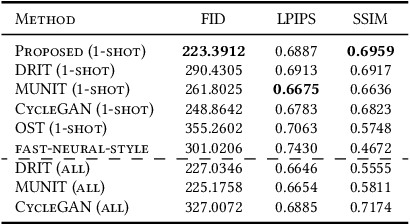
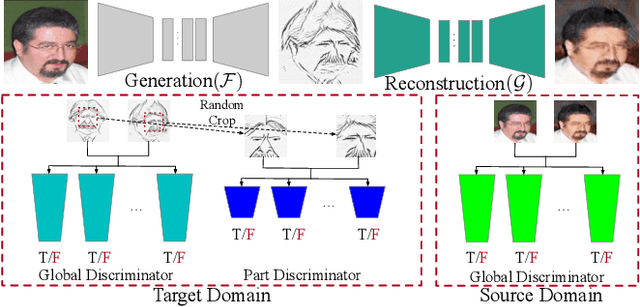
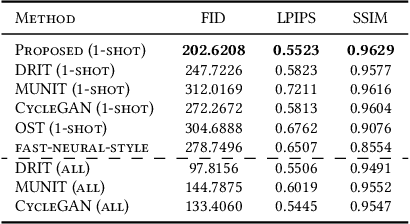
Abstract:It is well known that humans can learn and recognize objects effectively from several limited image samples. However, learning from just a few images is still a tremendous challenge for existing main-stream deep neural networks. Inspired by analogical reasoning in the human mind, a feasible strategy is to translate the abundant images of a rich source domain to enrich the relevant yet different target domain with insufficient image data. To achieve this goal, we propose a novel, effective multi-adversarial framework (MA) based on part-global learning, which accomplishes one-shot cross-domain image-to-image translation. In specific, we first devise a part-global adversarial training scheme to provide an efficient way for feature extraction and prevent discriminators being over-fitted. Then, a multi-adversarial mechanism is employed to enhance the image-to-image translation ability to unearth the high-level semantic representation. Moreover, a balanced adversarial loss function is presented, which aims to balance the training data and stabilize the training process. Extensive experiments demonstrate that the proposed approach can obtain impressive results on various datasets between two extremely imbalanced image domains and outperform state-of-the-art methods on one-shot image-to-image translation.
Generative Adversarial Network with Multi-Branch Discriminator for Cross-Species Image-to-Image Translation
Jan 24, 2019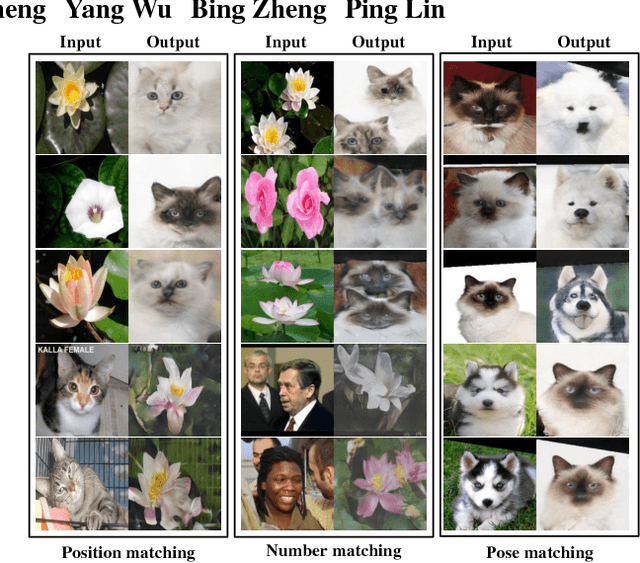
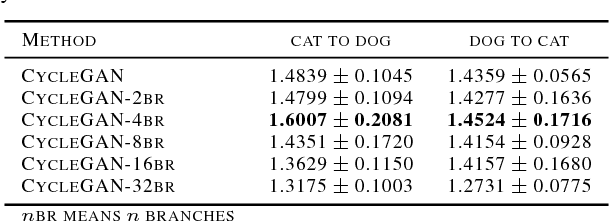
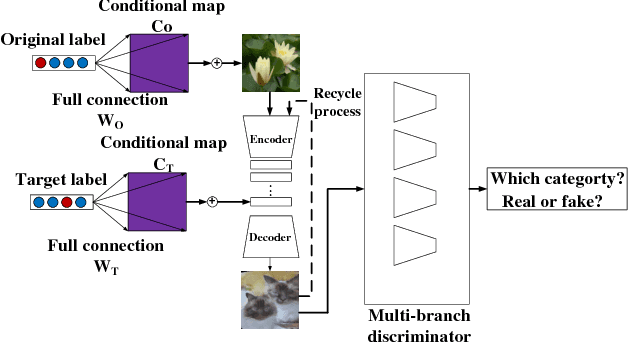
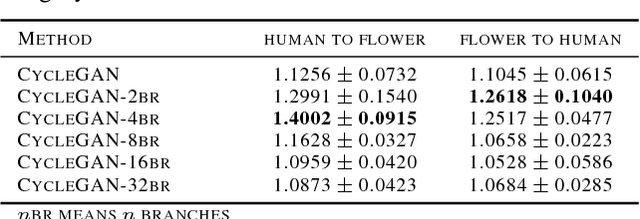
Abstract:Current approaches have made great progress on image-to-image translation tasks benefiting from the success of image synthesis methods especially generative adversarial networks (GANs). However, existing methods are limited to handling translation tasks between two species while keeping the content matching on the semantic level. A more challenging task would be the translation among more than two species. To explore this new area, we propose a simple yet effective structure of a multi-branch discriminator for enhancing an arbitrary generative adversarial architecture (GAN), named GAN-MBD. It takes advantage of the boosting strategy to break a common discriminator into several smaller ones with fewer parameters, which can enhance the generation and synthesis abilities of GANs efficiently and effectively. Comprehensive experiments show that the proposed multi-branch discriminator can dramatically improve the performance of popular GANs on cross-species image-to-image translation tasks while reducing the number of parameters for computation. The code and some datasets are attached as supplementary materials for reference.
Discriminative Region Proposal Adversarial Networks for High-Quality Image-to-Image Translation
Aug 06, 2018
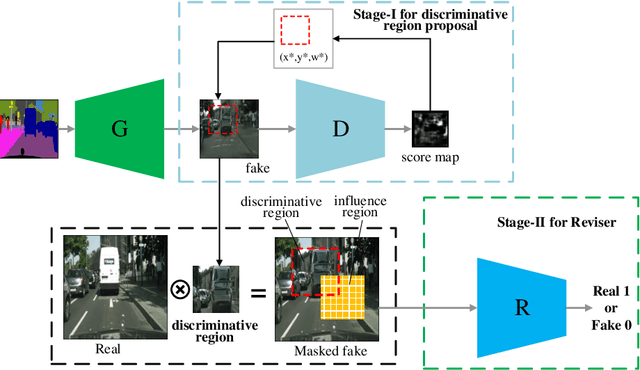


Abstract:Image-to-image translation has been made much progress with embracing Generative Adversarial Networks (GANs). However, it's still very challenging for translation tasks that require high quality, especially at high-resolution and photorealism. In this paper, we present Discriminative Region Proposal Adversarial Networks (DRPAN) for high-quality image-to-image translation. We decompose the procedure of image-to-image translation task into three iterated steps, first is to generate an image with global structure but some local artifacts (via GAN), second is using our DRPnet to propose the most fake region from the generated image, and third is to implement "image inpainting" on the most fake region for more realistic result through a reviser, so that the system (DRPAN) can be gradually optimized to synthesize images with more attention on the most artifact local part. Experiments on a variety of image-to-image translation tasks and datasets validate that our method outperforms state-of-the-arts for producing high-quality translation results in terms of both human perceptual studies and automatic quantitative measures.
Unpaired Photo-to-Caricature Translation on Faces in the Wild
Jul 25, 2018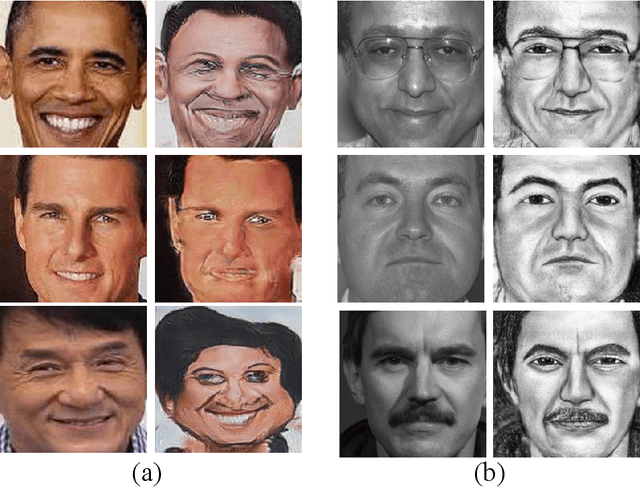
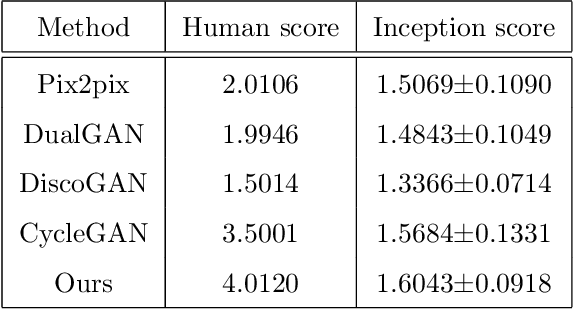
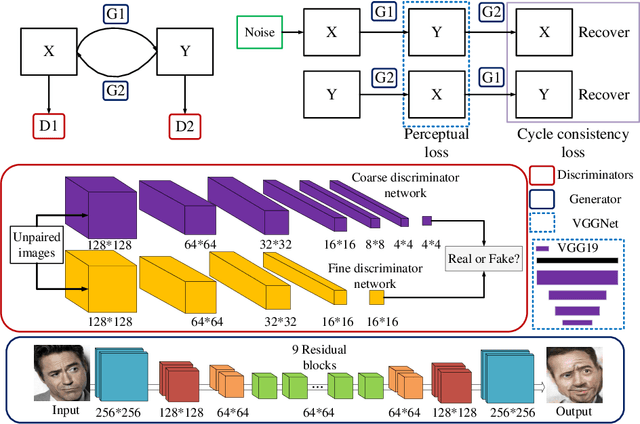

Abstract:Recently, image-to-image translation has been made much progress owing to the success of conditional Generative Adversarial Networks (cGANs). And some unpaired methods based on cycle consistency loss such as DualGAN, CycleGAN and DiscoGAN are really popular. However, it's still very challenging for translation tasks with the requirement of high-level visual information conversion, such as photo-to-caricature translation that requires satire, exaggeration, lifelikeness and artistry. We present an approach for learning to translate faces in the wild from the source photo domain to the target caricature domain with different styles, which can also be used for other high-level image-to-image translation tasks. In order to capture global structure with local statistics while translation, we design a dual pathway model with one coarse discriminator and one fine discriminator. For generator, we provide one extra perceptual loss in association with adversarial loss and cycle consistency loss to achieve representation learning for two different domains. Also the style can be learned by the auxiliary noise input. Experiments on photo-to-caricature translation of faces in the wild show considerable performance gain of our proposed method over state-of-the-art translation methods as well as its potential real applications.
Instance Map based Image Synthesis with a Denoising Generative Adversarial Network
Jan 10, 2018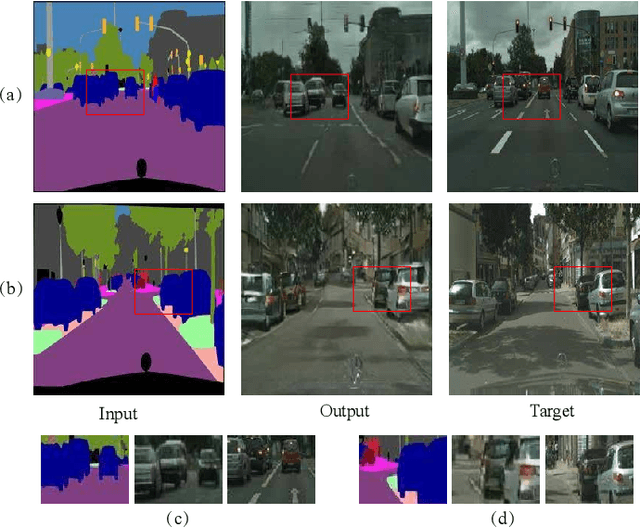

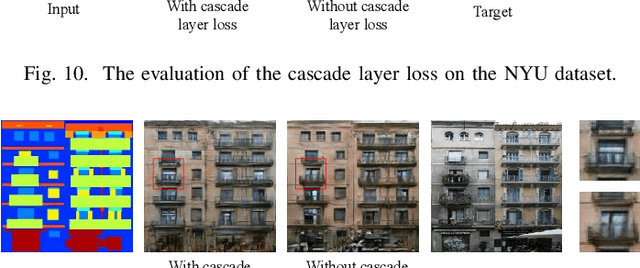
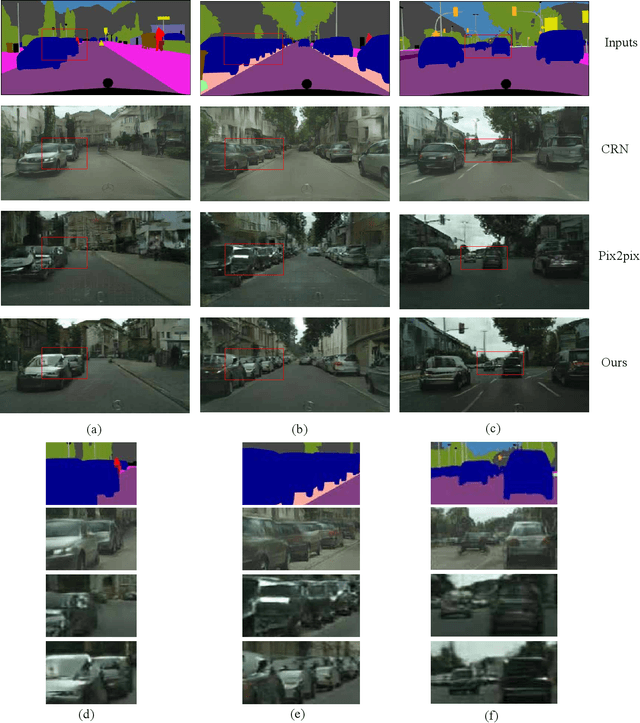
Abstract:Semantic layouts based Image synthesizing, which has benefited from the success of Generative Adversarial Network (GAN), has drawn much attention in these days. How to enhance the synthesis image equality while keeping the stochasticity of the GAN is still a challenge. We propose a novel denoising framework to handle this problem. The overlapped objects generation is another challenging task when synthesizing images from a semantic layout to a realistic RGB photo. To overcome this deficiency, we include a one-hot semantic label map to force the generator paying more attention on the overlapped objects generation. Furthermore, we improve the loss function of the discriminator by considering perturb loss and cascade layer loss to guide the generation process. We applied our methods on the Cityscapes, Facades and NYU datasets and demonstrate the image generation ability of our model.
 Add to Chrome
Add to Chrome Add to Firefox
Add to Firefox Add to Edge
Add to Edge